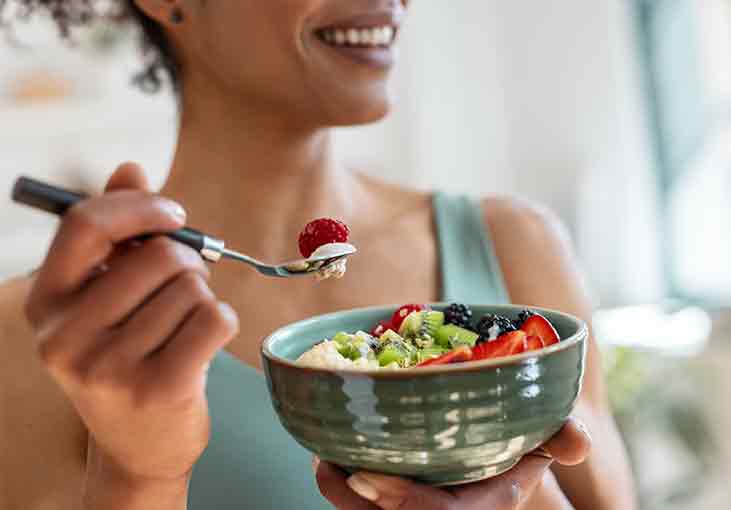Making changes to your diet can feel overwhelming at times, especially with all the opinions and over-the-top goals you might see online. The good news is that changing nutrition habits can be done in a way that is healthy and sustainable for personal well-being. Use the worksheet below to check off what’s working for you right now—and identify those habits you’d like to work on to be more in line with your goals. Also, for more in-depth strategies on improving your habits, be sure to read the article on strategic habits for better nutrition.
Published on: August 26, 2024
References
American Dietetic Association, Dietitians of Canada, American College of Sports Medicine, Rodriguez, N. R., Di Marco, N. M., & Langley, S. (2009). American College of Sports Medicine position stand. Nutrition and athletic performance. Medicine and Science in Sports and Exercise, 41(3), 709–731. doi:10.1249/MSS.0b013e31890eb86
American Heart Association. (2024). Fruits and vegetables serving sizes infographic. Retrieved 6 August 2024 from https://www.heart.org/en/healthy-living/healthy-eating/add-color/fruits-and-vegetables-serving-sizes
Barber, T. M., Kabisch, S., Pfeiffer, A. F. H., & Weickert, M. O. (2020). The health benefits of dietary fibre. Nutrients, 12(10), 3209. doi:10.3390/nu12103209
Chianese, R., Coccurello, R., Viggiano, A., Scafuro, M., Fiore, M., Coppola, G., & Meccariello, R. (2018). Impact of dietary fats on brain functions. Current Neuropharmacology, 16(7), 1059–1085. doi: 10.2174/1570159X15666171017102547
Clifton, P. M., & Keogh, J. B. (2017). A systematic review of the effect of dietary saturated and polyunsaturated fat on heart disease. Nutrition, Metabolism, and Cardiovascular Diseases: NMCD, 27(12), 1060–1080. doi:10.1016/j.numecd.2017.10.010
Cleveland Clinic (2023). How to tell when you’re full (before you feel stuffed). Retrieved 6 August 2024 from https://health.clevelandclinic.org/how-to-tell-when-you-are-full
Dighriri, I. M., Alsubaie, A. M., Hakami, F. M., Hamithi, D. M., Alshekh, M. M., Khobrani, F. A., & & Tawhari, M. Q. (2022). Effects of omega-3 polyunsaturated fatty acids on brain functions: A systematic review. Cureus, 14(10), e30091. doi:10.7759/cureus.30091
Gardner, B., Lally, P., & Wardle, J. (2012). Making health habitual: The psychology of ‘habit-formation’ and general practice. British Journal of General Practice, 62(605), 664–666. doi:10.3399/bjgp12X659466
Głąbska, D., Guzek, D., Groele, B., & Gutkowska, K. (2020). Fruit and vegetable intake and mental health in adults: A systematic review. Nutrients, 12(1), 115. doi:10.3390/nu12010115
Guest, N. S., VanDusseldorp, T. A., Nelson, M. T., Grgic, J., Schoenfeld, B. J., Jenkins, N. D. M., , & Campbell, B. I. (2021). International Society of Sports Nutrition position stand: Caffeine and exercise performance. Journal of the International Society of Sports Nutrition, 18(1), 1. doi:10.1186/s12970-020-00383-4
Hawton, K., Ferriday, D., Rogers, P., Toner, P., Brooks, J., Holly, J., & Hinton, E. (2018). Slow down: Behavioural and physiological effects of reducing eating rate. Nutrients, 11(1), 50. doi:10.3390/nu11010050
Institute of Medicine & National Research Council. (2013). Individual, household, and environmental factors affecting food choices and access. In J. A. Caswell & A.L. Yaktine (Eds.), Supplemental Nutrition Assistance Program: Examining the evidence to define benefit adequacy. Washington, DC: National Academies Press.
Kerksick, C. M., Arent, S., Schoenfeld, B. J., Stout, J. R., Campbell, B., Wilborn, C. D.,... Antonio, J. (2022). International Society of Sports Nutrition position stand: Nutrient timing. Journal of the International Society of Sports Nutrition, 14(1). doi:10.1186/s12970-017-0189-4
Kim, J. S., Nam, K., & Chung, S. J. (2019). Effect of nutrient composition in a mixed meal on the postprandial glycemic response in healthy people: a preliminary study. Nutrition Research and Practice, 13(2), 126–133. doi:10.4162/nrp.2019.13.2.126
Nelson J. B. (2017). Mindful eating: The art of presence while you eat. Diabetes Spectrum: A publication of the American Diabetes Association, 30(3), 171–174. doi:10.2337/ds17-0015
Pem, D., & Jeewon, R. (2015). Fruit and vegetable intake: Benefits and progress of nutrition education interventions- narrative review article. Iranian Journal of Public Health, 44(10), 1309–1321.
Riebl, S. K., & Davy, B. M. (2013). The hydration equation: Update on water balance and cognitive performance. ACSM’s Health & Fitness Journal, 17(6):21–28. doi:10.1249/FIT.0b013e3182a9570f.
Rodriguez, D., Lavie, C. J., Elagizi, A., & Milani, R. V. (2022). Update on omega-3 polyunsaturated fatty acids on cardiovascular health. Nutrients, 14(23). doi:10.3390/nu14235146
U.S. Department of Agriculture. Fruits. Retrieved 6 August 2024 from https://www.myplate.gov/eat-healthy/fruits
U.S. Department of Agriculture and U.S. Department of Health and Human Services. (2020). Dietary guidelines for Americans, 2020–2025. Washington, DC: Retrieved 10 July 2024 from https://www.dietaryguidelines.gov/sites/default/files/2020-12/Dietary_Guidelines_for_Americans_2020-2025.pdf
World Health Organization. (2023). Increasing fruit and vegetable consumption to reduce the risk of noncommunicable diseases. Retrieved 6 August 2024 from https://www.who.int/tools/elena/interventions/fruit-vegetables-ncds
